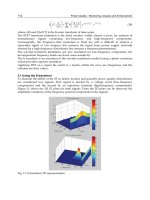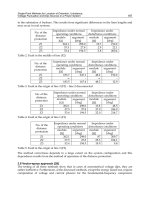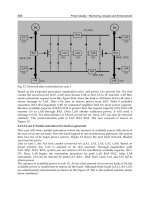Vibration Analysis and Control New Trends and Developments Part 7 docx
Bạn đang xem bản rút gọn của tài liệu. Xem và tải ngay bản đầy đủ của tài liệu tại đây (2.24 MB, 25 trang )
10 Vibration Control
derivatives of the flat output required for implementation of the controller (20):
˙
η
1
= η
2
˙
η
2
= η
3
˙
η
3
= η
4
˙
η
4
=
1
+ bu
˙
1
=
2
˙
2
=
3
.
.
.
˙
r−1
=
r
˙
r
= 0
y
= η
1
= L
(22)
where
1
= ,
2
=
˙
,
3
=
¨
, ···,
r
=
(
r−1
)
.
A Luenberger observer for the system (22) is then given by
˙
η
1
=
η
2
+ λ
r+3
(
y −
y
)
˙
η
2
=
η
3
+ λ
r+2
(
y −
y
)
˙
η
3
=
η
4
+ λ
r+1
(
y −
y
)
˙
η
4
=
1
+ bu + λ
r
(
y −
y
)
˙
1
=
2
+ λ
r−1
(
y −
y
)
˙
2
=
3
+ λ
r−2
(
y −
y
)
.
.
.
˙
r−1
=
r
+ λ
1
(
y −
y
)
˙
r
= λ
0
(
y −
y
)
y
=
η
1
(23)
The estimation error dynamics e
1
= y −
y satisfies the following dynamics:
e
(r+4)
1
+ λ
r+3
e
(
r+3
)
1
+ λ
r+2
e
(
r+2
)
1
+ λ
r+1
e
(
r+1
)
1
+ λ
r
e
(r)
1
+λ
r−1
e
(r−1)
1
+ ···+ λ
2
¨
e
+ λ
1
˙
e
1
+ λ
0
e
1
= 0
(24)
Therefore, the design parameters λ
i
, i = 0, ··· , r + 3, can be chosen so that the output
estimation error e
1
exponentially asymptotically converges to zero.
On the other hand, it is assumed that the perturbation input signal
(t) can be locally
approximated by a family of Taylor polynomials of fourth degree. Therefore, the characteristic
polynomial for the dynamics of output observation error (24) is given by
p
o2
= s
9
+ λ
8
s
8
+ λ
7
s
7
+ λ
6
s
6
+ λ
5
s
5
+ λ
4
s
4
+ λ
3
s
3
+ λ
2
s
2
+ λ
1
s + λ
0
(25)
It is then proposed the following Hurwitz polynomial to compute the proper gains for the
observer:
p
o2
(
s
)
=
(
s + p
2
)
s
2
+ 2ζ
2
ω
2
s + ω
2
2
4
(26)
140
Vibration Analysis and Control – New Trends and Developments
Control of Nonlinear Active Vehicle Suspension Systems Using Disturbance Observers 11
One then obtains that
λ
0
= p
2
ω
8
2
λ
1
= ω
8
2
+ 8p
2
ζ
2
ω
7
2
λ
2
= 8ω
7
2
ζ
2
+ 24p
2
ω
6
2
ζ
2
2
+ 4p
2
ω
6
2
λ
3
= 24ω
6
2
ζ
2
2
+ 4ω
6
2
+ 32p
2
ω
5
2
ζ
3
2
+ 24p
2
ω
5
2
ζ
2
λ
4
= 32ω
5
2
ζ
3
2
+ 24ω
5
2
ζ
2
+ 16p
2
ω
4
2
ζ
4
2
+ 48p
2
ω
4
2
ζ
2
2
+ 6p
2
ω
4
2
λ
5
= 16ω
4
2
ζ
4
2
+ 48ω
4
2
ζ
2
2
+ 6ω
4
2
+ 32p
2
ω
3
2
ζ
3
2
+ 24p
2
ω
3
2
ζ
2
λ
6
= 32ω
3
2
ζ
3
2
+ 24ω
3
2
ζ
2
+ 24p
2
ω
2
2
ζ
2
2
+ 4p
2
ω
2
2
λ
7
= 24ω
2
2
ζ
2
2
+ 4ω
2
2
+ 8p
2
ω
2
ζ
2
λ
8
= p
2
+ 8ω
2
ζ
2
with p
2
, ω
2
, ζ
2
> 0.
From the practical viewpoint, main advantage of this high-gain observer is that it could be
employed for hydraulic or electromagnetic active vehicle suspension systems, requiring only
information of the stiffness constant of tire k
t
and the unsprung mass m
u
. In addition, it
can be shown that the proposed observer design methodology is quite robust with respect to
parameter uncertainty and unmodeled dynamics, by considering the parameter variations
into the perturbation input signal
(
t
)
. In fact, in (Sira-Ramirez et al., 2008a) has been
presented through some experimental results that the polynomial disturbance signal-based
GPI control scheme, implemented as a classical compensation network, is robust enough with
respect to parameter uncertainty and unmodeled dynamics in the context of an off-line and
pre-specified reference trajectory tracking tasks.
It is important to emphasize that, the proposed results are now possible thanks to the existence
of commercial embedded system for automatic control tasks based on high speed FPGA/DSP
boards with high computational performance operating at high sampling rates. The proposed
observer could be implemented via embedded software applications without many problems.
5. Simulation results
Some numerical simulations were performed on a nonlinear quarter-vehicle suspension
system characterized by the following set of realistic parameters (Tahboub, 2005) to verify
the effectiveness of the proposed disturbance observer-control design methodology (see Table
1):
Parameters Values
Sprung mass (m
s
) 216.75 [kg]
Unsprung mass (m
u
) 28.85 [kg]
Spring stifness (k
s
) 21700 [
N
m
]
Damping constant (c
s
) 1200 [
N·s
m
]
Tire stifness (k
t
) 184000 [
N
m
]
nonlinear spring stiffness (k
ns
) 2170 [
N
m
]
nonlinear damping constant (c
ns
) 120 [
N·s
m
]
Table 1. Parameters of the vehicle suspension system.
141
Control of Nonlinear Active Vehicle Suspension Systems Using Disturbance Observers
12 Vibration Control
Fig. 2 shows some schematic diagram for the implementation of the proposed active vibration
controllers based on on-line disturbance estimation using a flatness-based controller and GPI
observers.
Fig. 2. Schematic diagram of the instrumentation for active vehicle suspension control
implementation.
The following trajectory was utilized to simulate the unknown exogenous disturbance
excitations due to irregular road surfaces (Chen & Huang, 2005):
z
r
(
t
)
=
⎧
⎪
⎪
⎪
⎪
⎨
⎪
⎪
⎪
⎪
⎩
f
1
(
t
)
+
f
(
t
)
for t ∈ [3.5, 5)
f
2
(
t
)
+
f
(
t
)
for t ∈ [5, 6.5)
f
3
(
t
)
+
f
(
t
)
for t ∈ [8.5, 10)
f
3
(
t
)
+
f
(
t
)
for t ∈ [10, 11.5
f
(
t
)
else
with
f
1
(
t
)
= −
0.0592
(
t − 3.5
)
3
+ 0.1332
(
t − 3.5
)
2
f
2
(
t
)
=
0.0592
(
t − 6.5
)
3
+ 0.1332
(
t − 6.5
)
2
f
3
(
t
)
=
0.0592
(
t − 8.5
)
3
− 0.1332
(
t − 8.5
)
2
f
3
(
t
)
= −
0.0592
(
t − 11.5
)
3
− 0.1332
(
t − 11.5
)
2
f
(
t
)
=
0.002 sin
(
2πt
)
+
0.002 sin
(
7.5πt
)
Figs. 3-9 describe the robust performance of the controller (7) using the observer (14). It can
be seen the high vibration attenuation level of the active vehicle suspension system compared
with the passive counterpart.
142
Vibration Analysis and Control – New Trends and Developments
Control of Nonlinear Active Vehicle Suspension Systems Using Disturbance Observers 13
Moreover, one can observe a robust and fast on-line estimation of the disturbance ξ(t) as well
as the corresponding time derivatives of the flat output up to third order. Similar results on
the implementation of the controller (20) with disturbance observer (23) for estimation of the
perturbation
(
t
)
and time derivatives of the flat output are shown in Figs. 10-23.
In the computer simulations it is assumed that the perturbation input signals ξ
(t) and
(
t
)
can be locally approximated by a family of Taylor polynomials of fourth degree.
The characteristic polynomials for the ninth order observation error dynamics were all set to
be of the following form:
p
o
(
s
)
=
(
s + p
o
)
s
2
+ 2ζ
o
ω
o
s + ω
2
o
4
with p
o
= ω
o
= 300rad/s and ζ
o
= 20.
The characteristic polynomials associated with the closed-loop dynamics were all set to be of
the form: p
c
(
s
)
=
s
2
+ 2ζ
c
ω
c
s + ω
2
c
2
,withω
c
= 10rad/s and ζ
c
= 0.7071.
0 5 10 15
−0.15
−0.1
−0.05
0
0.05
0.1
0.15
t [s]
Displacement [m]
Active
Passive
Road profile
Fig. 3. Sprung mass displacement response using controller (7) and observer (14).
0 5 10 15
−0.8
−0.6
−0.4
−0.2
0
0.2
0.4
0.6
0.8
1
t [s]
Acceleration [m/s
2
]
Active
Passive
Fig. 4. Sprung mass acceleration response using controller (7) and observer (14).
In general, the proposed active vehicle suspension using a flatness-based controller and GPI
observers for the estimation of unknown perturbations yields good attenuation properties and
an overall robust performance.
143
Control of Nonlinear Active Vehicle Suspension Systems Using Disturbance Observers
14 Vibration Control
0 5 10 15
−0.15
−0.1
−0.05
0
0.05
0.1
0.15
t [s]
Deflection [m]
Active
Passive
Fig. 5. Suspension deflection response (x
1
− x
3
) using controller (7) and observer (14).
0 5 10 15
−1
−0.8
−0.6
−0.4
−0.2
0
0.2
0.4
0.6
0.8
1
x 10
−3
t [s]
Deflection [m]
Active
Passive
Fig. 6. Tire deflection response (x
3
− z
r
) using controller (7) and observer (14).
0 5 10 15
−2
−1.5
−1
−0.5
0
0.5
1
1.5
2
x 10
7
t [s]
Perturbation Signal
Estimated perturbation
Actual perturbation
Fig. 7. Perturbation estimation ξ(t) using observer (14).
144
Vibration Analysis and Control – New Trends and Developments
Control of Nonlinear Active Vehicle Suspension Systems Using Disturbance Observers 15
0 5 10 15
−10
0
10
t [s]
First
derivative
0 5 10 15
−200
−100
0
100
200
t [s]
Second
derivative
0 5 10 15
−2
0
2
x 10
4
t [s]
Third
derivative
Estimate Actual value
Estimate Actual value
Estimate Actual value
Fig. 8. Estimation of time derivatives of the flat output using the observer (14).
0 5 10 15
−2500
−2000
−1500
−1000
−500
0
500
1000
1500
2000
2500
t [s]
u [N]
Fig. 9. Control force using the observer (14).
0 5 10 15
−0.2
−0.15
−0.1
−0.05
0
0.05
0.1
0.15
t [s]
Displacement [m]
Active
Passive
Road profile
Fig. 10. Sprung mass displacement response using controller (20) and observer (23).).
145
Control of Nonlinear Active Vehicle Suspension Systems Using Disturbance Observers
16 Vibration Control
0 5 10 15
−1
−0.8
−0.6
−0.4
−0.2
0
0.2
0.4
0.6
0.8
1
t [s]
Acceleration [m/s
2
]
Active
Passive
Fig. 11. Sprung mass acceleration response using controller (20) and observer (23).
0 5 10 15
−0.15
−0.1
−0.05
0
0.05
0.1
0.15
t [s]
Deflection [m]
Active
Passive
Fig. 12. Suspension deflection response (x
1
− x
3
) using controller (20) and observer (23).
0 5 10 15
−1
−0.8
−0.6
−0.4
−0.2
0
0.2
0.4
0.6
0.8
1
x 10
−3
t [s]
Deflection [m]
Active
Passive
Fig. 13. Tire deflection response (x
3
− z
r
) using controller (20) and observer (23).
146
Vibration Analysis and Control – New Trends and Developments
Control of Nonlinear Active Vehicle Suspension Systems Using Disturbance Observers 17
0 5 10 15
−2
−1.5
−1
−0.5
0
0.5
1
1.5
2
x 10
7
t [s]
Perturbation signal
Estimated perturbation
Actual perturbation
Fig. 14. Perturbation estimation
(
t
)
using observer (23).
0 5 10 15
−10
−5
0
5
10
t [s]
First
derivative
0 5 10 15
−200
−100
0
100
200
t [s]
Second
derivative
0 5 10 15
−1
−0.5
0
0.5
1
x 10
4
t [s]
Third
derivative
Estimate Actual value
Estimate Actual value
Estimate Actual value
Fig. 15. Estimation of time derivatives of the flat output using the observer (23).
0 5 10 15
−2500
−2000
−1500
−1000
−500
0
500
1000
1500
2000
2500
t [s]
u [N]
Fig. 16. Control force using the observer (23).
147
Control of Nonlinear Active Vehicle Suspension Systems Using Disturbance Observers
18 Vibration Control
6. Conclusions
In this chapter a robust active vibration control scheme, based on real-time estimation
and rejection of perturbation signals, of nonlinear vehicle suspension systems is described.
The proposed approach exploits the structural property of differential flatness exhibited
by the suspension system fot the synthesis of a flatness based controller and a robust
observer. Therefore, a perturbed input-output differential equation describing the dynamics
of the flat output is obtained for design purposes of the control scheme. The exogenous
disturbances due to irregular road surfaces, nonlinear effects, parameter variations and
unmodeled dynamics are lumped into an unknown bounded time-varying perturbation
input signal affecting the differentially flat linear simplified dynamic mathematical model
of the suspension system. A family of Taylor polynomials of (r-1)th degree is used to
locally approximate this perturbation signal. Hence the perturbation signal is described by
a rth-order mathematical model. Then, the perturbed suspension system model is expressed
as a (r+4)th-order extended mathematical model.
The design of high-gain Luenberger observers, based on this kind of extended models, is
proposed to estimate the perturbation signal and some time derivatives of the flat output
required for implementation of differential flatness-based disturbance feedforward and
feedback controllers for attenuation of vibrations in electromagnetic and hydraulic active
vehicle suspension systems.
Two high-gain disturbance observer-based controllers have been proposed to attenuate the
vibrations induced by unknown exogenous disturbance excitations due to irregular road
surfaces, which could be employed for nonlinear quarter-vehicle active suspension models by
using hydraulic or electromagnetic actuators. Computer simulations were included to show
the effectiveness of the proposed controllers, as well as of the disturbance observers based on
Taylor polynomials of fourth degree.
The results show a high vibration attenuation level of the active vehicle suspension system
compared with the passive counterpart and, in addition, a robust and fast real-time estimation
of the disturbance and time derivatives of the flat output.
7. References
Ahmadian, M. Active control of vehicle suspensions. In: Encyclopedia of Vibration, Edited by
Braun, S.G., Ewins, D.J. & Rao, S.S. (2001), Vols. 1-3, Academic Press, San Diego, CA.
Basterretxea, K., Del Campo, I. & Echanobe, J. (2010). A semi-active suspension embedded
controller in a FPGA, 2010 IEEE International Symposium on Industrial Embedded
Systems, pp. 69-78, Trento, July 7-9.
Beltran-Carbajal, F., Silva-Navarro, G., Blanco-Ortega, A. & Chavez-Conde, E. (2010a).
Active Vibration Control for a Nonlinear Mechanical System using On-line Algebraic
Identification, In: Vibration Control, M. Lallart, (Ed.), 201-214, Sciyo, Rijeka, Croatia.
Beltran-Carbajal, F., Silva-Navarro, G., Sira-Ramirez, H. & Blanco-Ortega, A. (2010b).
Application of on-line algebraic identification in active vibration control, Computación
ySistemas, Vol. 13, No. 3, pp. 313-330.
Cao, J., Liu, H., Li, P. & Brown, D. (2008). State of the Art in Vehicle Active Suspension
Adaptive Control Systems Based on Intelligent Methodologies, IEEE Transaction on
Intelligent Transportation Systems, Vol. 9, No. 3, pp. 392-405.
148
Vibration Analysis and Control – New Trends and Developments
Control of Nonlinear Active Vehicle Suspension Systems Using Disturbance Observers 19
Choi, S.B., Lee, H.K. & Chang, E.G. (2001). Field test results of a semi-active ER suspension
system associated with skyhook controller, Mechatronics, Vol. 11, pp. 345-353.
Chavez-Conde, E., Beltran-Carbajal, F., Garcia-Rodriguez, C. & Blanco-Ortega, A. (2009a).
Sliding Mode Based Differential Flatness Control and State Estimation of Vehicle
Active Suspensions System, IEEE In ternational Conference on Electrical Engineering,
Computing Science and Automatic Control, pp. 544-549, Toluca, Mexico, November
10-13.
Chavez-Conde, E., Beltran-Carbajal, F., Blanco-Ortega, A. & Mendez-Azua, H. (2009b).
Sliding Mode and Generalized PI Control of Vehicle Active Suspensions, 18th
IEEE International Conference on Control Applications, pp. 1726-1731, Saint Petersburg,
Russia, July 8-10.
Chen, P. & Huang, A. (2005). Adaptive sliding control of non-autonomous active suspension
systems with time-varying loadings, Journal of Sound and Vibration, Vol. 282, pp.
1119-1135.
Fliess, M., Marquez, R., Delaleau, E. & Sira-Ramirez, H. (2002). Correcteurs
Proportionnels-Integraux Généralisés, ESAIM Control, Optimisation and Calculus
of Variations , Vol. 7, pp. 23-41.
Fliess, M., Marquez, R. & Delaleau, E. (2001). State feedbacks without asymptotic observers
and generalized PID regulators, Nonlinear Control in the Year 2000, Lecture Notes in
Control and Information Sciences, Vol. 258, pp. 367-384, Springer, London.
Fliess, M., Lévine, J., Martin, Ph. & Rouchon, P. (1993). Flatness and defect of nonlinear
systems: introductory theory and examples, Intern ational Journal of Control,Vol.61,
No. 6, pp. 1327-1361.
Gysen, B.L.J., Paulides, J.J.H., Janssen, J.L.G. & Lomonova, E. A. (2008). Active
Electromagnetic Suspension System for Improved Vehicle Dynamics, IEEE Vehicle
Power and Propulsion Conference (VPPC), Harbin, China, September 3-5.
Isermann, R. & Munchhpf, M. (2011). Identification of Dynamic Systems, Springer-Verlag, Berlin.
Martins, I., Esteves, J., Marques, D.G. & Da Silva, F. P. (2006). Permanent-Magnets Linear
Actuators Applicability in Automobile Active Suspensions, IEEE Trans. on Vehicular
Techn ology, Vol. 55, No. 1, pp. 86-94.
Sira-Ramirez, H., Beltran-Carbajal, F. & Blanco-Ortega, A. (2008a). A Generalized Proportional
Integral Output Feedback Controller for the Robust Perturbation Rejection in a
Mechanical System, e-STA Sciences et Technologies de l’Automatique,Vol.5,No.4,pp.
24-32.
Sira-Ramirez, H., Feliu-Batlle, V., Beltran-Carbajal, F. & Blanco-Ortega, A. (2008b).
Sigma-Delta modulation sliding mode observers for linear systems subject to locally
unstable inputs, 16th Mediterranean Conference on Control and Automation, pp. 344-349,
Ajaccio, France, June 25-27.
Sira-Ramirez, H., Barrios-Cruz, E. & Marquez-Contreras, R.J. (2009). Fast adaptive trajectory
tracking control for a completely uncertain DC motor via output feedback,
Computación y Sistemas, Vol. 12, No. 4, pp. 397-408.
Sira-Ramirez, H., Silva-Navarro, G. & Beltran-Carbajal, F. (2007). On the GPI balancing control
of an uncertain Jeffcot rotor model, 2007 4th International Conference on Electrical and
Electronics E ngineering (ICEEE), pp. 306-309, Mexico City, Mexico, September 5-7.
Sira-Ramirez, H. & Agrawal, S.K. (2004). Differentially Flat Systems, Marcel Dekker, New York.
149
Control of Nonlinear Active Vehicle Suspension Systems Using Disturbance Observers
20 Vibration Control
Shoukry, Y., El-Kharashi, M. W. & Hammad, S. (2010). MPC-On-Chip: An Embedded GPC
Coprocessor for Automotive Active Suspension Systems, IEEE Embedded Systems
Letters, Vol. 2, No. 2, pp. 31-34.
Tahboub, K. A. (2005). Active Nonlinear Vehicle-Suspension Variable-Gain Control, 13th
Mediterranean Conference on Control and Automation, pp. 569-574, Limassol, Cyprus,
June 27-29.
van der Schaft, A. (2000). L
2
−Gain and Passivity Techniques in Nonlinear Control,Springer,
London.
Ventura, P.J.C., Ferreira, C.D.H., Neves, C. F. C. S., Morais, R.M.P., Valente, A.L.G. & Reis,
M.J.C.S. (2008). An embedded system to assess the automotive shock absorber
condition under vehicle operation, IEEE Sensor 2008 Conference, pp. 1210-1213, Lecce,
October 26-29.
Yao, G.Z., Yap, F.F., Chen, G., Li, W.H. & Yeo, S.H. (2002). MR damper and its application for
semi-active control of vehicle suspension system, Mechatronics, Vol. 12, pp. 963-973.
150
Vibration Analysis and Control – New Trends and Developments
2 Will-be-set-by-IN-TECH
R
R
S
0
I 1
152
Vibration Analysis and Control – New Trends and Developments
Semi-active Control of Civil Structures Based on the Prediction of the Structural Response: Integrated Design Approach 3
( ) ( )
( )
=
( )
( )
( )= ( ( ) ( )) + ( )( ( ) ( ))
( ( ) ( ))
( )( ( ) ( ))
( )
= ( + ) ( )=
+
( )
( ) =
Mq
( )+D( )q( )+Kq( )=b w( )+b ( )w( )+b w( )
M
= M + M D( )=D + D ( ) b ( )=b + b ( ) b = b + b
q
( ) R w( ) R
M D K
S b R =
153
Semi-Active Control of Civil Structures
Based on the Prediction of the Structural Response: Integrated Design Approach
4 Will-be-set-by-IN-TECH
M
D b b
M
D ( )
b
( ) b D
b
x
( )=Ax( )+Bu ( )
z( )=C x( )+D u ( )
x
( ) =
q
( )
q( )
u
( ) =
⎡
⎣
w
( )
w( )
w( )
⎤
⎦
u
( ) =
w
( )
w( )
A
=
0
I
M K M D( )
B
=
0
M
b
b ( ) b
z
( ) R
z
( )
A B C
D ( ) =
( ) =
154
Vibration Analysis and Control – New Trends and Developments
Semi-active Control of Civil Structures Based on the Prediction of the Structural Response: Integrated Design Approach 5
( ) =
( )=
⎧
⎨
⎩
=
=
z ( + )Q z( + )
>
Q
= Q
z
( )
z
(
+
)
=
C x
(
+
)
+
D u
(
+
)
x
( + ) z( + )
x
(
+
)
x
( )
+
x
( )
u
(
+
)
u
( )
+
u
( )
z
(
+
)
x
( )
u
( )
x
( )
u ( ) =
x
( )
=
Ax
( )
+
Bu ( )
155
Semi-Active Control of Civil Structures
Based on the Prediction of the Structural Response: Integrated Design Approach
6 Will-be-set-by-IN-TECH
x
( )
u
( )
u
( )=
w
( )
w( )
=
w
( )
w( )
z
( + )
( )
( )
( ( ))
= ( )+ ( ) =
>
z( )
z
( )
156
Vibration Analysis and Control – New Trends and Developments
Semi-active Control of Civil Structures Based on the Prediction of the Structural Response: Integrated Design Approach 7
( )= =
α
α <
( )= =
α <
α
=
( )= =
α
α
–
–
157
Semi-Active Control of Civil Structures
Based on the Prediction of the Structural Response: Integrated Design Approach
8 Will-be-set-by-IN-TECH
=
=
( )
(
)
=
=
=
[
Q
]
=
Q
[
Q
]
=
([
Q
] )
[
Q
]
([
Q
] )
=
= λ +
(
λ
)
< λ <
=
=
=
=
( )
= =
158
Vibration Analysis and Control – New Trends and Developments
Semi-active Control of Civil Structures Based on the Prediction of the Structural Response: Integrated Design Approach 9
( ) =
=
⎛
⎝
( )
( )
⎞
⎠
( ) =
=
⎛
⎝
( )
( )
⎞
⎠
( ) =
=
⎛
⎝
( )
( )
⎞
⎠
( ) =
=
⎛
⎝
( )
( )
⎞
⎠
=
=
=
=
( ) =
=
⎛
⎝
( )
( )
⎞
⎠
( ) =
=
⎛
⎝
( )
( )
⎞
⎠
( ) =
=
⎛
⎝
( )
( )
⎞
⎠
( ) =
=
⎛
⎝
( )
( )
⎞
⎠
=
( )
= =
< λ < =
=
= =
=
159
Semi-Active Control of Civil Structures
Based on the Prediction of the Structural Response: Integrated Design Approach
10 Will-be-set-by-IN-TECH
=
= =
=
( )
=
D
D
= βK β >
β
>
= [ ]
= [ ]
= =
( )
=
( )
= =
=
=
=
=
=
160
Vibration Analysis and Control – New Trends and Developments
Semi-active Control of Civil Structures Based on the Prediction of the Structural Response: Integrated Design Approach 11
=
z
( )
z
( )=
⎡
⎢
⎢
⎣
r
( )
r( )
q( )
q( )
⎤
⎥
⎥
⎦
= C x
( )
+
D u
( )
161
Semi-Active Control of Civil Structures
Based on the Prediction of the Structural Response: Integrated Design Approach
12 Will-be-set-by-IN-TECH
q
( ) r( )
q
( )=
⎡
⎢
⎢
⎢
⎣
( )
( )
( )
⎤
⎥
⎥
⎥
⎦
r
( )=
⎡
⎢
⎢
⎢
⎣
( )
( )
( )
⎤
⎥
⎥
⎥
⎦
=
⎡
⎢
⎢
⎢
⎣
( ) ( )
( ) ( )
( ) ( )
⎤
⎥
⎥
⎥
⎦
C
D
C
=
⎡
⎣
R0
0 R
I
⎤
⎦
D
=
⎡
⎣
s0
0 s
0
⎤
⎦
R
=
⎡
⎢
⎢
⎢
⎢
⎢
⎣
⎤
⎥
⎥
⎥
⎥
⎥
⎦
s
=
0
( )
= =
z
( ) Q
Q
Q
=
1 1 1 1 1 1
1 1 1 1 1 1
>
=
162
Vibration Analysis and Control – New Trends and Developments
Semi-active Control of Civil Structures Based on the Prediction of the Structural Response: Integrated Design Approach 13
= = =
=
[ ]
[ ]
NC (Nominal structure):
NC (Optimized structure):
Pon (Nominal structure):
Pon (Optimized structure):
SA (Nominal structure):
SA (Optimized structure):
Energy-based SA (Optimized structure):
( )
( )
163
Semi-Active Control of Civil Structures
Based on the Prediction of the Structural Response: Integrated Design Approach









